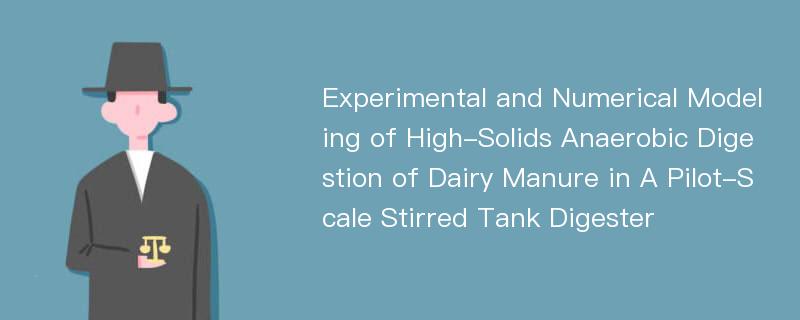
论文摘要
该论文采用实验与计算流体力学(CFD)模拟相结合的方法,研究在中温条件下高固含率牛粪厌氧发酵过程。牛粪呈现非牛顿幕律流体特性。实验装置为中试规模的搅拌发酵罐,水力停留时间(HRT)为30天。采用六桨叶涡轮搅拌桨对发酵液进行混合,桨叶倾斜角为45°。实验采用非搅拌混合方式,设置了三种搅拌强度,速度分别为50、100和150rpm,旨在确定最优的搅拌强度(以最低能耗提高厌氧发酵效率)。由甲烷产量和产气率可知,搅拌强度100rpm比50rpm的产气率高,且这两个搅拌强度的产气率均高于150rpm的。与搅拌强度50rpm和100rpm的产气实验相比,150rpm时的甲烷产量分别降低了18%和21%。实验结果表明,搅拌强度为100rpm是最佳的经济转速(以千瓦时为单位的净发电量),其次是50rpm与150rpm。CFD模拟预测的非牛顿幕律流体搅拌能耗与实验测量值一致。实验和CFD计算结果表明,最少的搅拌次数为每天一次,可以节省99%的甲烷输出产能(仅1%的甲烷输出产能用于搅拌)。通过进一步的CFD模拟优化,当搅拌强度由50rpm增加到100rpm,增幅设定为10rpm;结果表明:以甲烷产量为目标的最优搅拌强度在70rpm至80rpm之间,而且通过分析平均速度和平均速度梯度,确定70rpm为最佳转速。通过水力参数的CFD分析证明了超过临界搅拌强度对微生物活性有不利的影响。模拟结果证明CFD是模拟厌氧发酵搅拌的有用工具。研究结果表明,每个厌氧消化装置都存在一个搅拌强度的临界值,超过该临界值时增加搅拌强度是浪费能源,并且不会增加甲烷产量,反而可能减少甲烷产量。因此,在该实验条件下最佳甲烷产量的搅拌强度在50至100rpm范围内。针对每个厌氧消化方案,净能量输出是用于确定搅拌方式、搅拌强度、搅拌时间以及搅拌频率的最佳标准。当HRT从30天减少至20天时,厌氧消化过程就会不稳定,并引起了严重泡沫,难以控制,试验就会中断。在稳定的运行条件下,利用一个简单的数学模型可以预测甲烷产量;研究表明,在化学计量法中引进生物降解性因子是一种简单准确的方法,可用于模拟运行条件对甲烷产量的影响。
论文目录
摘要AbstractAnnotationsChapter 1 Introduction 1.1 Background 1.2 Aims and Objectives 1.3 Specific Objectives 1.4 Knowledge Gaps 1.5 Research Scope 1.6 Anaerobic Digestion 1.6.1 Advantages of Anaerobic Digestion 1.6.2 Anaerobic Biochemical Processes 1.7 Environmental Factors 1.7.1 Temperature 1.7.2 pH 1.7.3 Alkalinity 1.7.4 VFAs Concentration 1.7.5 Nutrients and Trace Elements 1.7.6 Hydraulic Retention Time and Solids Retention Time 1.7.7 Organic Loading Rate 1.8 Characterization of Manure 1.9 Research Methods 1.9.1 The Experimental Setup 1.9.2 Dairy Cattle Manure 1.9.3 Inoculum for the Startup ProcessChapter 2 Influence of Mixing on Anaerobic Digestion Efficiency in Stirred Tank Digesters 2.1 Background 2.2 Comparison of Mixing Intensity and Power Requirements of Impeller, SlurryRecirculation and Gas Mixing 2.3 Effect of Mixing/Shear Intensity on Microorganisms 2.4 Effect of Mixing Intensity on AD Efficiency 2.5 Effects of Mixing Mode and Duration on AD Efficiency 2.6 Effects of Mixing on Scum, Crust and Foam Formation 2.7 Effects of Mixing on the HRT/SRT 2.8 Effect of Mixing on VFA 2.9 Summary and Analysis of Different Observations 2.10 Brief SummaryChapter 3 Influence of Minimal Mixing Intensity on High-Solids Anaerobic Digestion Energy Efficiency 3.1 Background 3.2. Materials and Methods 3.2.1 Non-Mixed Experiment 3.2.2 Effect of Mixing Intensity 3.2.3 Effect of Change in HRT and OLR 3.2.4 Data Comparison 3.3 Results and Discussion 3.3.1 Comparison of the Methane Yield and Specific Methane Production Rate 3.3.2 Comparison of the Net Energy Production 3.3.3 The Effect of OLR and HRT 3.4 Brief SummaryChapter 4 Predicting the Methane Productivity and Specific Methane Production Rate 4.1 Background 4.1.1 Mathematical Modeling 4.2 Materials and Methods 4.2.1 Modeling the Startup Process 4.2.2 Gompertz Growth 4.2.3 First Order Kinetics 4.2.4 Modeling the Effects of Mixing Intensities on HSAD 4.3 Results and Discussion 4.3.1 Specific Biogas and Methane Production Rate of the Startup Process 4.3.2 Gompertz Growth Model Fit 4.3.3 First Order Kinetics 4.3.4 Modeling the Effect of Mixing Intensities using the Stoichiometric Method 4.3.5 Modeling the Effects of Mixing Intensities on HSAD using Karim's Model 4.3.6 Simple Linear Model 4.4 Brief SummaryChapter 5 Physical and Rheological Properties of Cattle Manure 5.1 Background 5.2 Review of Equations and Values for Consistency Coefficient 5.3 Review of Equations and Values for Flow Behavior Index 5.4 summarize the ranges of reported values of n as a function of manure type, TS, temperature and shear rate (γ). 5.5 Brief SummaryChapter 6 CFD Simulations of Mixing for High-Solids Anaerobic Digestion of Dairy Manure in a Pilot-Scale 6.1 Background 6.2 Model Development 6.2.1 Assumptions 6.2.2 Governing Equations 6.2.3 Numerical Approach 6.3 Experimental Setup 6.4 Results and Discussion 6.4.1 Grid Independence Study 6.4.2 Model Validation 6.4.3 Qualifying Flow Patterns 6.4.4 Quantifying Flow Patterns 6.4.5 Shear Rate 6.4.6 Turbulent Kinetic Energy 6.4.7 Velocity Gradient 6.4.8 Predicting the Influence of Flow Hydrodynamics on Floc Breakup and Growth. 6.4.9 Mixing Energy Level(MEL) 6.4.10 Mixing Time 6.4.11 Local Mixing Time 6.4.12 Global Mixing Time 6.4.13 Time Evolution of Tracer Concentration 6.4.14 Net Energy Production 6.4.15 Optimization of the Mixing Intensity 6.4.16 The Effects of Total Solids Concentration on the Velocity Distributions and thePower Consumption. 6.5 Brief SummaryChapter 7 ConclusionReferencesAcknowledgementsList of Academic Papers Published during the Study
文章来源
类型: 博士论文
作者: IBRAHIM DENKA KARIYAMA
导师: 吴斌鑫
关键词: 中试规模厌氧发酵器,高固含率厌氧发酵,计算流体力学,搅拌强度,净能量输出,甲烷产出,流变特性
来源: 江苏大学
年度: 2019
分类: 基础科学
专业: 力学
单位: 江苏大学
基金: the Natural Science Foundation of China (51878318),the Priority Academic Program Development of Jiangsu Higher Education Institutions
分类号: O35
DOI: 10.27170/d.cnki.gjsuu.2019.000112
总页数: 235
文件大小: 6438K
下载量: 23
相关论文文献
- [1].搅拌强度对浮选机内液-固两相流场特性影响[J]. 东北大学学报(自然科学版) 2018(09)
- [2].厌氧发酵池搅拌强度控制及有效性预测研究[J]. 现代农业科技 2014(23)
- [3].聚四氢呋喃废水中回收磷的试验研究[J]. 长春工程学院学报(自然科学版) 2010(03)
- [4].搅拌强度变化对煤泥浮选中药剂吸附的影响[J]. 煤炭技术 2018(12)
- [5].M-EMS搅拌强度对钢轨钢MnS析出的影响研究[J]. 连铸 2017(04)
- [6].搅拌强度在中药水提液絮凝效果中的影响[J]. 科技经济市场 2017(10)
- [7].优化化学生物絮凝工艺搅拌强度的试验研究[J]. 能源与环境 2009(04)
- [8].淬火冷却系统的设计及计算机模拟[J]. 热处理 2012(01)
- [9].搅拌强度和水固比对石灰消化性能的影响研究[J]. 宁夏工程技术 2017(03)
- [10].正交实验确定餐厨垃圾厌氧发酵主要影响因素[J]. 广东化工 2016(09)
- [11].搅拌强度对“两相分区一体”沼气发酵工艺产气效率的影响[J]. 中国农业大学学报 2017(05)
- [12].磷酸结晶介稳区性质的研究[J]. 高校化学工程学报 2010(02)
- [13].利用沉淀法提取磷酸铵镁结晶回收污水中磷的试验[J]. 材料导报 2014(24)
- [14].响应面法优化厌氧上清液除磷的研究[J]. 中国环境科学 2014(01)
- [15].广西某低品位软锰矿还原焙烧—酸浸工艺研究[J]. 中国锰业 2012(02)
- [16].LF底吹搅拌过程自动控制[J]. 山东冶金 2016(02)
- [17].化灰机的技术改造[J]. 纯碱工业 2010(04)
- [18].金源矿业公司充填系统搅拌桶改造实践[J]. 黄金 2015(07)
- [19].电磁搅拌对定向凝固Al-Cu合金组织和耐磨性能的影响[J]. 内蒙古工业大学学报(自然科学版) 2012(01)
- [20].CaO添加顺序对废弃泥浆絮凝效果的影响[J]. 探矿工程(岩土钻掘工程) 2018(07)
- [21].由硫酸镁铵溶液制备Mg(OH)_2的实验研究[J]. 轻金属 2018(08)
- [22].DIBK-TBP体系萃取铪和锆的动力学研究[J]. 有色金属(冶炼部分) 2014(02)
- [23].赣南某钨矿山废水悬浮物处理试验研究[J]. 中国钨业 2014(05)
- [24].搅拌强度对全混式沼气池加温过程及加温能耗的影响[J]. 可再生能源 2011(01)
- [25].粉煤灰除磷的试验研究[J]. 中国西部科技 2009(26)
- [26].电磁搅拌对铝偏析提纯中溶质径向分布的影响[J]. 云南冶金 2019(03)
- [27].影响酸奶粘度的主要因素分析[J]. 中国奶牛 2011(23)
- [28].钛合金新型阳极氧化工艺参数影响规律研究[J]. 教练机 2011(02)
- [29].蟹壳生物吸附剂对水中镍离子的吸附研究[J]. 净水技术 2008(01)
- [30].WFGD条件下脱硫石膏结晶特性的实验研究[J]. 上海电力学院学报 2012(06)
标签:中试规模厌氧发酵器论文; 高固含率厌氧发酵论文; 计算流体力学论文; 搅拌强度论文; 净能量输出论文; 甲烷产出论文; 流变特性论文;
Experimental and Numerical Modeling of High-Solids Anaerobic Digestion of Dairy Manure in A Pilot-Scale Stirred Tank Digester
下载Doc文档
